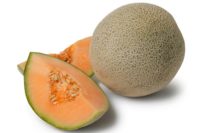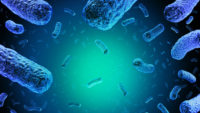Source: American Society for Microbiology
Caption for image at left: This image shows photos of biofilms on surfaces at low magnification (300) and high magnification (3000) using an electron microscope. (Click the image to see a larger version.)
Once Salmonella bacteria get into a food processing facility and have an opportunity to form a biofilm on surfaces, it is likely to be extraordinarily difficult, if not impossible, to kill those bacteria, according to research published ahead of print in the journal Applied and Environmental Microbiology.
Researchers from National University of Ireland, Galway conducted a study in which they attempted to kill Salmonella biofilms on a variety of hard surfaces, using three types of disinfectant.
"We found that it was not possible to kill the Salmonella cells using any of the three disinfectants, if the biofilm was allowed to grow for seven days before the disinfectant was applied," said Mary Corcoran, a researcher involved in the study. Even soaking the biofilms in disinfectant for an hour and a half failed to kill them.
The impetus for the study was a European outbreak of salmonellosis in which 160 people in 10 countries became ill with gastroenteritis (vomiting and diarrhea) from the Agona serotype of Salmonella, Corcoran stated. That outbreak was traced to meat from a major food processing facility.
"It seems that Salmonella Agona entered into the environment in the part of the facility where meat that was already cooked was being handled, and it had survived and contaminated the cooked meat," said Corcoran. "We were interested in determining if this particular [strain of] Salmonella, which caused the outbreak, might have something special about it that makes it better at surviving in the environment of a food processing facility. Was it better at forming a dense biofilm, or was it more resistant to disinfectants than other [strains of] Salmonella?"
The research uncovered nothing special about that specific strain.
"We found that all of the types of Salmonella we looked at were able to adopt the specialized biofilm lifestyle on all of the surfaces we looked at, including glass, stainless steel, glazed tile, and plastic, and that the biofilm of Salmonella gets more dense over time, and becomes more firmly attached to the surface," Corcoran explained.
Corcoran warned that food processing facilities must take strict care to keep Salmonella out of the clean areas where cooked foods are further processed and packaged.
"People need to question whether disinfectants that are promoted as killing various types of bacteria are truly as effective in real-life situations, where biofilms can form, as they are claimed to be based on experiments that do not involve biofilms. A lot of the time, the disinfectant may add very little, if anything, to good cleaning and appropriate food handling practices," Corcoran asserted. "There is a need for more research to define better methods for killing Salmonella biofilms."
In the U.S., an estimated million-plus cases of salmonellosis occur annually, with 23,000 hospitalizations and 450 fatalities reported each year, according to the Centers for Disease Control and Prevention (CDC).
A copy of the manuscript can be found online at http://bit.ly/asmtip0114e. The final version of the article is scheduled for the February 2014 issue of Applied and Environmental Microbiology, a publication of the American Society for Microbiology.




